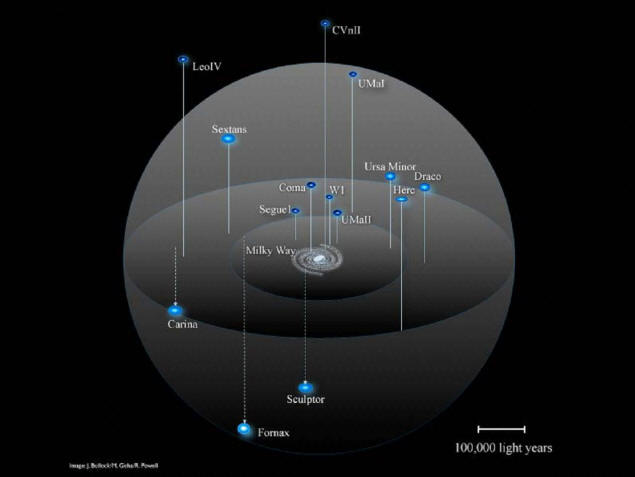|
|
From Ptolemy to Dark Matter -
Part 1
Aug
07, 2009
Fundamental
assumptions have an overwhelming
influence on how we interpret and
discuss new observations.
One such assumption
that shapes our accepted view of the
Universe is that gravity dominates
the motion of galaxies.
It is difficult to change these
types of fundamental belief systems.
For example, in the time of the
Hellenic astronomer Claudius
Ptolemaeus, it was a widely held
fundamental assumption that the
Earth was the center of the cosmos.
In fact, there were many good
reasons to believe it. The stars,
the sun, and the planets visibly
move across the sky and the Earth
obviously feels very solid and
fixed.
According to the best thinkers at
the time, the heavenly bodies were
positioned on invisible spheres with
as many as five spheres per planet.
By allowing for spheres within
spheres, one could explain the
retrograde movement of the planets.
To its credit, much was explained
with this world-view. With Ptolemy’s
sophisticated use of epicycles,
deferents, and the innovative
introduction of the equant, the
Ptolemaic system was very successful
at predicting such things as the
precession of equinoxes as well as
planetary motion (more so than the
Copernican system when it was first
developed).
However, by the sixteenth century,
Galileo’s observations of the phases
of Venus were completely
incompatible with the Ptolemaic
system. Subsequently, Kepler’s
prediction of the transit of Venus
in 1631 was a great success for the
heliocentric, Copernican view of the
solar system.
Not to be unnecessarily provocative,
but there are interesting
similarities between the Ptolemaic
paradigm and the current theories
surrounding Dark Matter and
galaxies. Just as there were good
reasons to believe in invisible
celestial spheres driving a
Geocentric Model, there are reasons
to believe in invisible spheres
(called “haloes”) of dark matter
surrounding galaxies.
It all has to do with how the mass
of a galaxy is measured. One popular
approach to compute galactic mass is
the orbital method. In the orbital
method, the rotational velocity of
stars (the red shift of radio waves
from hydrogen gas around the stars)
is used to infer the mass of the
galaxy. The math is relatively
straightforward: once the stellar
orbital velocity (or “velocity
dispersion” for the galaxy) and the
distance from the center of the
galaxy that contains the mass in
question are measured, then it is
easy to solve for mass. However, the
math only includes gravity as the
potential energy source for the
system.
The problem that begets dark matter
is as follows. When the mass of a
galaxy with this gravity-only
approach is derived, there is more
computed mass than visible matter.
That is, the sum of the mass of all
the stars and visible dust in the
galaxy is far less than the mass
derived with the Orbital Method. If
gravity drives the rotational
velocity of the stars in the galaxy,
then there must be hidden mass in
the form of invisible dark matter.
What if gravity is not the dominant
force driving the rotational
velocity of galaxies?
Today, asking this question is like
asking a learned astronomer in 1550,
“What if the Earth is not at the
center of the cosmos?” Asserting
that gravity is not a dominant
dynamical force in the motion of
galaxies is just as shocking to
astronomers of our current time.
However, there is good evidence that
supports the notion that
electromagnetic forces in plasma act
on the cosmological scale.
Hannes Alfven (Nobel Laureate for
his work in plasma physics),
proposed that galaxies reside in
immense, gyrating, Birkeland
currents that convert large-scale
electromagnetic forces into
rotational energy in a galactic
system. In turn, leakage currents in
the galaxy are converted into
rotational energy in star systems.
Seminal work by Anthony Peratt (e.g.
see
Snell and Peratt, 1995) has
shown that the flat rotational curve
of galaxies is well modeled by
plasma simulations without the need
for dark matter. All the
observations of the galactic core,
the intense X-rays, gamma rays and
rotational energies could be
explained with sufficient current
densities driving the galactic
system (Peratt,
1986).
The typical flat rotational velocity
curve of a galaxy does not indicate
hidden dark matter mass, it
indicates that another force is at
work. This is why deriving the mass
of a galaxy using equations that
only include gravity as the source
of potential energy leads to
problems. Additional electromagnetic
forces are at work that drive the
galaxy like an electric homopolar
motor (see a summary in Donald
Scott’s book “The Electric Sky”).
To be continued.
Contributed by Thomas Wilson
|
|
|
|
|
|
SPECIAL NOTE - **New Volumes Available:
We are pleased to announce a new
e-book series
THE UNIVERSE ELECTRIC. Available now, the first volume
of this series, titled Big Bang, summarizes the failure of modern cosmology
and offers a new electrical perspective on the cosmos. At
over 200 pages, and
designed for broadest public appeal, it combines spectacular
full-color graphics with lean and readily understandable
text.
**Then second and third volumes in the series are now available,
respectively titled Sun and Comet, they offer
the reader easy to understand explanations of how and why these bodies
exist within an Electric Universe.
High school and college students--and teachers in
numerous fields--will love these books. So will a large
audience of general readers.
Visitors to the Thunderbolts.info site have often
wondered whether they could fully appreciate the Electric
Universe without further formal education. The answer is
given by these exquisitely designed books. Readers from
virtually all backgrounds and education levels will find them
easy to comprehend, from start to finish.
For the Thunderbolts Project, this series is a milestone.
Please see for yourself by checking out the new
Thunderbolts Project website, our leading edge in
reaching new markets globally.
Please visit our
Forum
|
|
|
|
|
|
|
|







